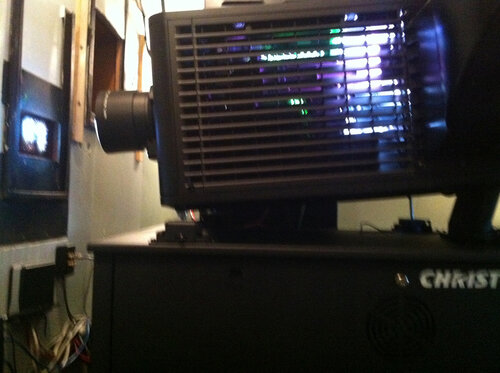
History of the Chautauqua Cinema
By Paul Schmidt. Appended by Billy Schmidt.
The Chautauqua Cinema is located in historic Higgins Hall located on the grounds of Chautauqua Institution. It has been a moviehouse for fully three fourths of its life, but when given to Chautauqua in 1895 by Frank Wayland Higgins (then a NY State senator and soon-to-be governor) and his sister Clara K. Smith in honor of their father, Orrin Trall Higgins, it was used for a variety of educational and performance purposes. Sturdily built of pressed brick with terra cotta trimmings, the portion with the pitched roof was a hall seating about 400 for speeches, recitals, plays, and yes, some religious services, although the building was not built as, nor intended to be, a church (a myth oft-repeated by misinformed tour guides).
The flat-roofed portion contained several smaller meeting rooms and a kitchen. Most of the Institution’s expanding programs for young women were headquartered in Higgins Hall, including the Girl’s Club and an especially adventurous sounding (for the late 19th century) women’s organization called The Outlook Club.
The building’s most illustrious day came in 1905 when U.S. President Theodore Roosevelt delivered a major policy speech in Chautauqua’s amphitheater, preceded by breakfast in Higgins Hall prepared by the Chautauqua domestic science class. In this photo taken on the Higgins Hall steps, Roosevelt (center) is flanked by Chautauqua cofounder John Heyl Vincent (also in top hat, on his left) and Jacob Riis, renowned social reformer (hat in hand) on his right. Riis’s presence undoubtedly had to do with the theme of the president’s message that day, which advocated – remember, he was a Republican – government checks on the runaway power of the huge corporations.
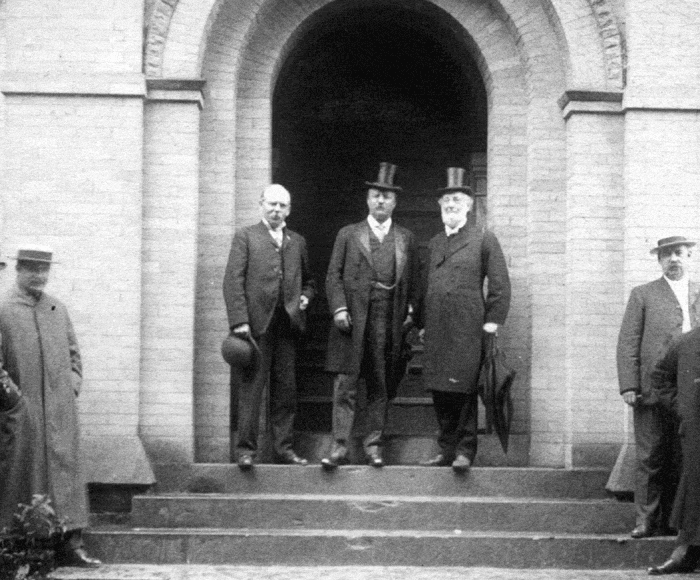
Interestingly, even as Higgins Hall was being constructed in 1895, Thomas Edison (who had married Chautauqua co-founder Lewis Miller’s daughter) was tinkering with his motion picture camera and projector while vacationing only a few hundred yards away. Chautauqua was also the scene of several meetings between Edison and George Eastman who developed the all-important continuous roll film (instead of individual plates) which made movies practicable.
Between 1911 and 1915, the play was the thing in Higgins Hall, which housed first the Coburn Players and then the Chautauqua Players. But the Magic of Movies took over Higgins Hall in 1916, presented by The Community Motion Picture Bureau in cooperation with the Institution, and films have been shown there ever since. (It’s interesting to note that Chautauquans’ thirst for the flickering images was so great that during the mid 1920s, movies were also shown in a second building known as the Hall of Expression which was located on the plaza where Smith Library now stands.) Photos of Higgins Hall during this early movie era are not available, but newspaper ads for the films that were shown (examples illustrated are from 1920, 1926, 1931, and 1937) do give us a sense of the period.
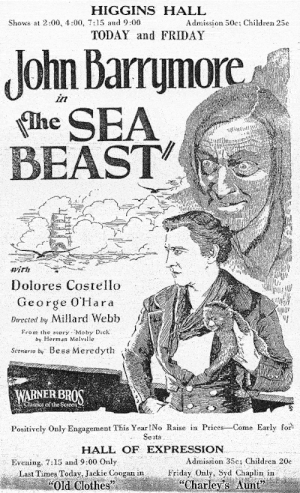
Also, sometime during the 1920s or 1930s (we can find no record that pinpoints the year), the peaked roof of Higgins Hall was extended the full length of the building, thus providing space for a balcony. A simple intersecting peak replaced the ornate decorations which had topped the original entrance. (They were literally lopped off. Evidence is visible in the attic space created by the new peak). A best guess is that the terra cotta material from which all of the ornamentation was made simply didn’t hold up under the severe conditions of western New York winters.

Chautauqua Institution ceased functioning as a presenter of movies in 1938 when it leased Higgins Hall to Joseph Woodburn, a retired actor and vaudeville performer, who operated it as a private business until his death in 1954. My memories (as a fifth-grader in 1952) are of Mr. Woodburn collecting the ticket money at a rickety little red table just inside the entrance doors.
A green burlap curtain just behind him tried (unsuccessfully) to keep the daylight from invading the darkened auditorium (there was no lobby) where wooden armless benches made watching “Quo Vadis” a painfully long sit and the peeling up linoleum in the unlighted aisles made a trip to the “rest room” an adventure in itself! In 1952, of course, there was a widespread assumption that television would shortly wipe out the remaining moviehouses. With that in mind, I suppose, the Woodburns had not invested much in physical improvements.
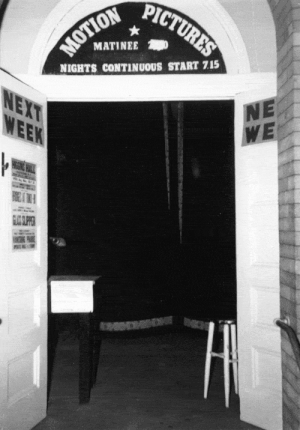
But everyone seemed to know and enjoy Joe and Margaret and I remember my delight at his referenes to Higgins Hall as “the palace of mirth.” By 1956, the lack of CinemaScope equipment made it impossible to show most of the current releases at Higgins Hall, and with audiences shrinking Margaret decided to sell the business to my father, Robert Schmidt, a teacher from nearby Mayville (and later its mayor). His annual need for a summer job had resulted in his working as the Woodburns’ projectionist during the previous four years and he felt there was a future for the business, a view not shared by a business-savvy brother of my mother’s who promptly proclaimed my folks insane for taking it on!
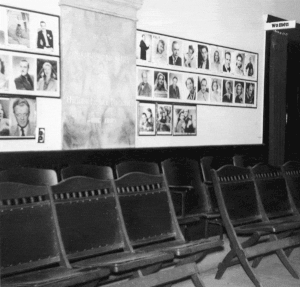
All the members of the Schmidt family dove into the new enterprise with relish. A series of improvements, carried out over several years, was undertaken – new entrance and marquee, lobby and restrooms, carpeting, reopening of the balcony, new seats and wall panelling, air conditioning, and all-important upgrades in projection and sound – so that by about 1965 the “Cinema” was pretty much as one sees it now.
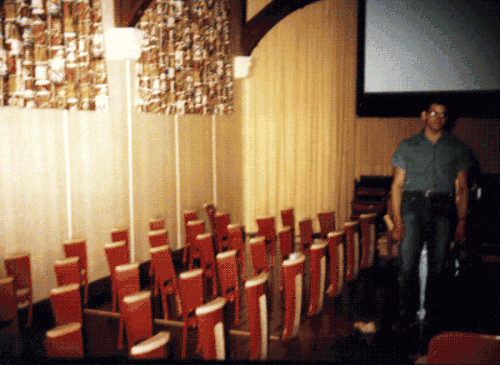
We did most of the work ourselves, often in zero cold during the winter months (installing air conditioning while ones hands are numb from cold is an emotionally conflicting experience.) Dad’s teaching specialty was industrial arts, and his varied skills were up to the challenge. The camera caught my lovely wife Merrillie, brush in hand, on a warmer day.
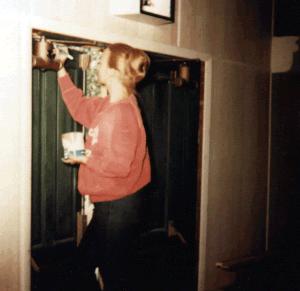
During the early 1980s, I had been gradually disengaging myself from the Cinema operation (my sons were now stepping in to help their grandfather), but when he died suddenly in 1985, I decided to carry on and turn the business in new directions. Resigning my teaching position in 1991, I became the “movieguy” on a full-time basis and during the 1990s, under the new banner of Uniplex Cinemas, Inc., we established wintertime programming in historic theaters in Jamestown and Fredonia, NY and in Warren and Bradford PA. Efforts in recent years to streamline Uniplex and prepare for an eventual transition have led us to pass the management of Jamestown, Fredonia and Bradford on to others.
Through the decades many physical improvements to the Chautauqua Cinema were undertaken. These included a new concessions stand (that replaced a bank of vending machines) in 1986, marquee and entrance refurbishment as well as interior redecoration and carpeting in 1998 and continued upgrades of our 35mm projection and sound systems including the installation of Dolby Digital 6-channel sound in 2003, and HD digital projection in 2007.
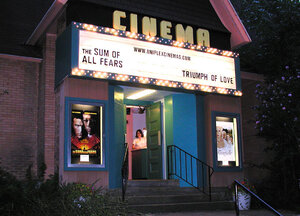
Jump forward to 2009 and the narration of this page changes from Paul to me, his son Bill. After 50 years of building the one of a kind Chautauqua Cinema into the treasure it is today your beloved movieguy Paul is finally taking his well deserved retirement. Those who know me will remember that as a boy I made quite a point to proclaim my independence. Certainly sticking around town and running the family business was well out of the question. My far reaching appetites led me as a young man to make a new home in San Francisco and find my living touring the world, honing my skills as a live audio engineer, a path that circuitously brought me to my own family.
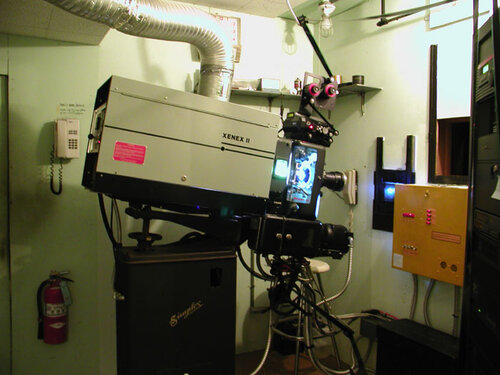
Now as the father of two boys, I have learned a bit about the rewards of commitment. When faced with my Pop’s decision to retire I realized I could not bear to let the Cinema go. It was more than nostalgia. This was an opportunity to immerse myself in art that I adore, run my own business and broaden my family’s lifestyle to include the blessings of summer in Chautauqua. How could we not?
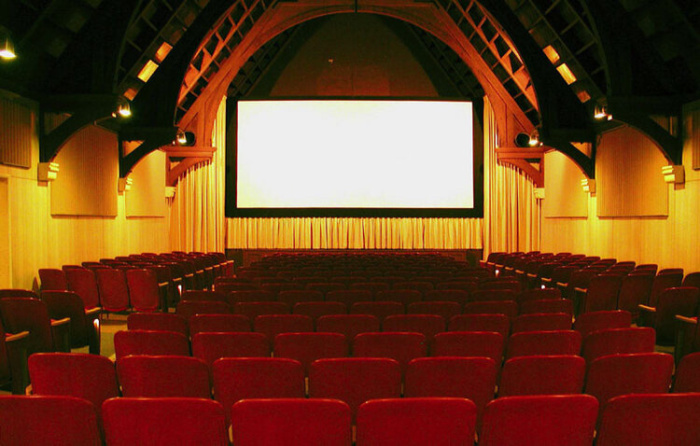
Jump foward to 2014 and the Cinema’s biggest challenge yet, the conversion to DCI compliant digital distribution and presentation for virtually all movies. The one time cost of these upgrades was far greater than the seasonal finaces of the Cinema could bear. So we asked our patrons for help! And the outpouring of generosity and love for the Cinema was absolutley amazing!
Through the support of our ‘Angels’ we were able invest in the equipment neccesary to not only keep the Cinema open but to keep our presentation standards top notch. We really couldn’t be happier with our new picture and sound. Ask for a tour of the projection booth if you are interested. We love to show off our gear!
